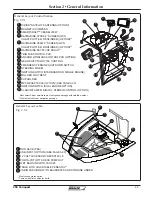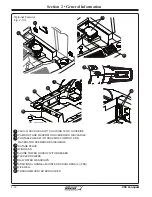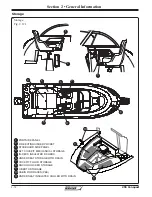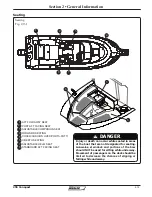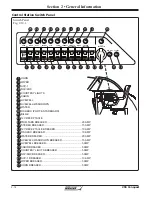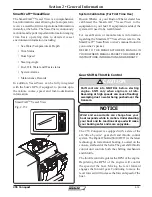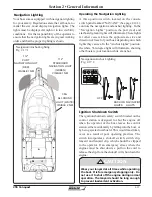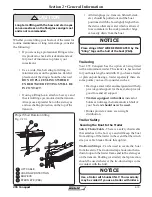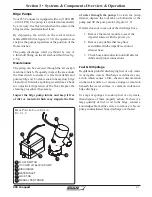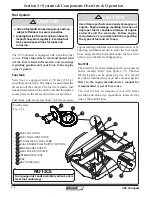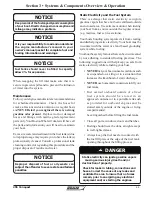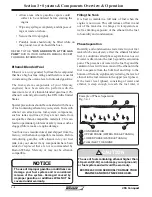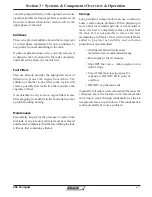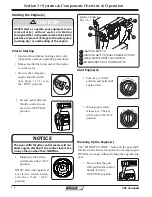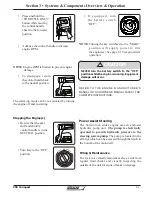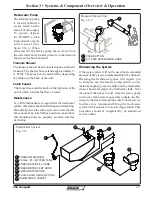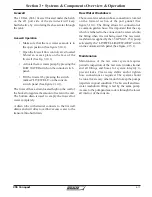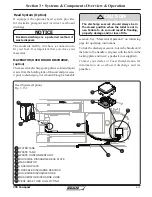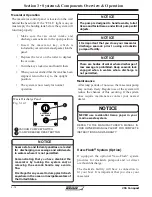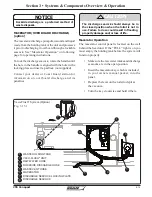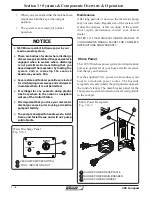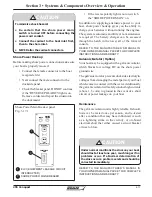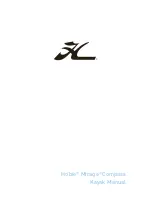
3-3
Section 3 • Systems & Components Overview & Operation
255 Conquest
R
NOTICE
it is your responsibility to read and understand
the engine manufacturer’s manual in your
owner’s manual packet for complete fuel and
fueling information and warnings.
When recapping the fi ll inlet make sure that it is
secure to prevent spills and to prevent the intrusion
of water into the system.
Follow your engine manufacturers recommendations
for scheduled maintenance. Check the hoses for
cracks, abrasions and deterioration on a regular basis
and
NEVER start your engines if there is a strong
gasoline odor present
. Replace worn or damaged
hoses and fi ttings with marine grade replacement
parts only. Your Boston Whaler® dealer will have all
the parts and information you will need to maintain
your boat.
Excessive water and sediment in the fuel tank(s) due
to improper usage may require you to have the tank(s)
professionally cleaned. Consult a professional tank
cleaning contractor regarding this procedure and the
proper disposal of residue and water.
Maintenance
Keep records of the fuel capacity and consumption
of your boat. Drastic changes in consumption and
mileage may indicate a problem.
NOTICE
Improper disposal of fuel or oily waste can
subject the offender to severe state and federal
penalties.
NOTICE
Static Electricity and the Fuel System
There is a danger that static electricity can ignite
gasoline vapors that have not been ventilated outside
an enclosed area. Use extreme caution when fueling
your boat from a source outside the regular venues,
(e.g. marinas, fuel service stations).
Your boats bonding system protects it from creating
and discharging static electricity. Your boat must be
in contact with the water or a land based grounding
system while fueling.
Your boat has safety features that can be circumvented
by not adhering to standard fueling practices. The
following suggestions will help keep you safe from
static electricity while refueling your boat.
•
NEVER
fuel your boat in unsafe conditions such
as suspended on a sling or in a situation that
increases the likelihood of static discharge.
•
NEVER
use homemade containers to fi ll your
fuel tanks.
• Fuel carried on-board outside of a fixed
f u e l s y s t e m s h o u l d b e s t o r e d i n a n
approved container or in a portable tank such
as provided for outboard engines and be
stowed safely outside of the engine or living
compartment(s).
be extinguished before fi lling the fuel tanks.
• Close all ports, windows, doors and hatches.
• Fueling should never be done at night except
in well-lighted areas.
• Always keep the fuel nozzle in contact with
the fuel fi ll plate or the edge of the fuel tank
opening throughout the fi lling process.
Static electricity can ignite gasoline vapors
causing serious injury/death and/or
destruction of property.
!
DANGER
Check for leaks in tubing, connections and
hoses. Correct the cause of any leaks and
ventilate the area to insure that no fumes
remain, prior to energizing any electrical
equipment and/or starting the engines.
Fuel tanks should never be fi lled to capacity.
Allow 2% for expansion.
NOTICE
Summary of Contents for 255 Conquest
Page 2: ......
Page 18: ...xviii 255 Conquest R THISPAGE INTENTIONALLY LEFT BLANK ...
Page 90: ...4 6 255 Conquest Section 4 Electrical System R Switch Panel Diagram Fig 4 6 1 ...
Page 91: ...4 7 Section 4 Electrical System 255 Conquest R DC Wiring Diagram Fig 4 7 1 ...
Page 94: ...4 10 255 Conquest Section 4 Electrical System R THIS PAGE INTENTIONALLY LEFT BLANK ...
Page 106: ...5 12 Section 5 Care Maintenance R 255 Conquest THIS PAGE LEFT INTENTIONALLY BLANK ...

